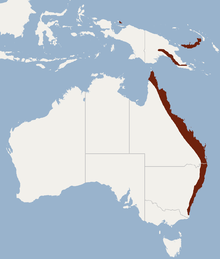Golden-tipped bat
The golden-tipped bat (Kerivoula papuensis) is a species of Microchiropteran in the family Vespertilionidae.[1] It is found in Papua New Guinea and in Australia, especially scattered along the eastern part of Australia.[2] The species is considered uncommon,[3] and is listed as endangered in Australia.[4]
| Golden-tipped bat | |
|---|---|
| Scientific classification | |
| Kingdom: | Animalia |
| Phylum: | Chordata |
| Class: | Mammalia |
| Order: | Chiroptera |
| Family: | Vespertilionidae |
| Genus: | Phoniscus |
| Species: | P. papuensis |
| Binomial name | |
| Phoniscus papuensis (Dobson, 1878) | |
 | |
| Synonyms | |
|
Kerivoula papuensis Dobson, 1878 | |
Description
The golden-tipped bat has brown color and broken color patterns on its pelage;[2] the body is covered with woolly fur.[4] Broken color patterns support crypsis in the golden-tipped bat;[4] thick pelage and wooly fur provide thermal insulation.[4] The average weight of adults is 6.7g.[4]
The wings of the golden-tipped bat show a low aspect ratio, with low wing loading. (That is, the wing is broad.) These wing features of support slow flight.[5][6] Additionally, the large tail membrane aids the wing membrane in enabling tight turns in flight.[5][6] Rounded wing tips also contribute to high maneuverability in flight.[5][6]
The golden-tipped bat also uses echolocation for foraging, with frequencies of approximately 155 kHz to 60 kHz.[5]
Habitat and ecology
The golden-tipped bat has been mainly recorded in rainforest or wet sclerophyll forest.[2] It has also been recorded in dry sclerophyll forest. They live at elevations up to 1,000m.[2]
Diet and foraging strategies
Diet
Araneida such as orb-weaver and big-jawed spiders are the main food of golden-tipped bats; as shown by the high proportion of Araneida body fragments among the particles lodged among the bats' teeth and fur.[5] Even though Araneida is a major food source for the golden-tipped bat, these bats also consume insects which belong to the insect orders Coleoptera (beetles) and Lepidoptera (butterflies and moths).[5]
Foraging strategies
The golden-tipped bat uses multiple foraging strategies to hunt. One is ground gleaning.[5]They also hover-glean, flying slowly and taking prey from elevated places such as high tree trunks.[5] The golden tipped bat use broad bandwidth echolocation to find precise localization of a target. Additionally, they use high frequency echolocation to find stationary prey such as spiders on their webs.[5]
References
- Parnaby, H; Mills, D (December 1994). "A Record of the Gold-tipped Bat from the Escarpment Forests". Australian Zoologist. 29: 3–4.
- "The Action Plan for Australian Bats". Environment Australia. Archived from the original on 7 September 2013.
- SCHULZ, M (1995). "Utilisation of suspended bird nests by the Golden-tipped Bat (kerivoula papuensis) in Australia". mammalia. 59 (2): 280–283.
- Schulz, M (1999). "Roosts used by the golden-tipped bat Kerivoula papuensis (Chiroptera: Vespertilionidae)". J. Zoology Journal of Zoology. 250: 467–478.
- SCHULZ, MARTIN. <0948:dafbot>2.0.co;2 "DIET AND FORAGING BEHAVIOR OF THE GOLDEN-TIPPED BAT,". Journal of Mammalogy. 81 (20 March 2000): 948–957. doi:10.1644/1545-1542(2000)081<0948:dafbot>2.0.co;2.
- Rhodes, Martin (1995). "Wing Morphology and Flight Behaviour of the Golden-tipped Bat, Phoniscus papuensis(Dobson) (Chiroptera:Vespertilionidae)". Australia.Z.Zoo. 43: 657–63. doi:10.1071/zo9950657.
